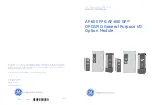
Pulse Instruments
System 4 Manual
Version 1.6
Visit us Online at
www.pulseinstrument.com
3
1. Overview
1.1 Introduction
Wash Water Sanitation by ORP for Fruits and Vegetables
Introduction:
In the ever-increasing need and awareness for food safety and HACCP, Water has become
a focus point for proper disinfection treatment as pathogens and harmful microorganisms can become a
danger for contamination of fresh fruits and vegetables during growing and post harvest contact. Water is
a critical control point of contact where proper treatment can greatly reduce these microbes, thereby
reducing the chances of food borne illness.
Typical water applications include:
1. Field and growing water including irrigation water
2. Post Harvest Pre-cooling operations: Hydrovac
™
, Ice Injection, and Hydro-cooling
3. Wash and Dip Tanks
4. Flume wash systems
5. Spray
wash
systems
Sanitizers:
Many water treatment sanitizers have been introduced in the market such as Chlorine,
Bromine, Ozone, Peroxyacetic Acid, Hydrogen Peroxide, Ultraviolet light (UV), as well as many
derivatives of Chlorine. These derivatives are Chlorine gas, Sodium Hypochlorite, Calcium Hypochlorite,
Chlorine Dioxide, Dichlor, Trichlor, and Hypochlorous Acid.
The Problem:
With so many chemical choices and food commodities, it becomes very difficult to
standardize upon an adequate treatment level. How much chemical (ppm) of each type to use for which
product under varying conditions of organic matter, dirt load, wash contact time, temperature, pH and
pressure or vacuum?
ORP the Solution:
The objective of using any sanitizer is to disinfect the water and destroy pathogens. All
mentioned sanitizers except UV are oxidizers and they all create oxidation. The stronger the oxidation,
the faster the microbe is killed. By measuring this oxidation level, we can directly measure the rate at
which these microbes are killed. ORP (Oxidation Reduction Potential) is a measure of the oxidation level
in the water and is measured in mV (millivolts) and thereby measures the activity of the sanitizer rather
than its concentration levels (ppm). The choice of sanitizer may be left up to the user bearing in
consideration, their own process requirements.
Standard for Water Disinfection:
Research has shown that at a level of 650 mV of ORP, bacteria such as
E. Coli are killed on contact or within a few seconds. Yeasts and molds may require typically 750 mV or
higher in order to be killed. Regardless of any type of oxidizer or any combination of sanitizer, and
regardless of other varying water conditions, if there is adequate ORP, there will be proper disinfection.
Balancing pH and keeping the organic and dirt load low helps in the strain and demand of the water,
therefore it is recommended that clean water quality be maintained as best possible which will also
reduce the amount of sanitizer needed to reach effective ORP.
Measurement of ORP:
There are several types of ORP measurement meters that vary depending on the
process requirements and design. Regardless of their style and design they all have a sensor (electrode)
that measures the ORP made of Platinum, and an instrument that reads the ORP electrode value.
All ORP meters and electrodes need to be kept moist and require periodic cleaning and calibration check
with standards of known value to ensure reliability and accuracy. Measurement is made by simply
dipping the electrode in liquid and observing the display. A stable reading is normally reached within a
couple of minutes.








































